The Role of Racism and Ethnocentrism in Australian Inequality
VerifiedAdded on 2022/11/13
|10
|2827
|157
Essay
AI Summary
This essay delves into the pervasive issues of racism and ethnocentrism in Australia, arguing that they are major contributors to societal inequality. The paper examines various manifestations of racism, including racial profiling, stereotypes, and hate speech, illustrating how these phenomena lead to discrimination and prejudice. The essay provides an overview of Australia's multicultural background and highlights the experiences of diverse groups, such as Aboriginal and Torres Strait Islander peoples, Muslims, and African Australians, who face significant challenges due to racial biases. It further explores how racial stereotypes and public discourse exacerbate inequality, leading to divisions and the violation of human rights. The author emphasizes the importance of combating racism through education and promoting diversity to foster a more inclusive and equitable society. The essay concludes by advocating for changes in attitudes and behaviors to create a society that values diversity and peaceful coexistence.
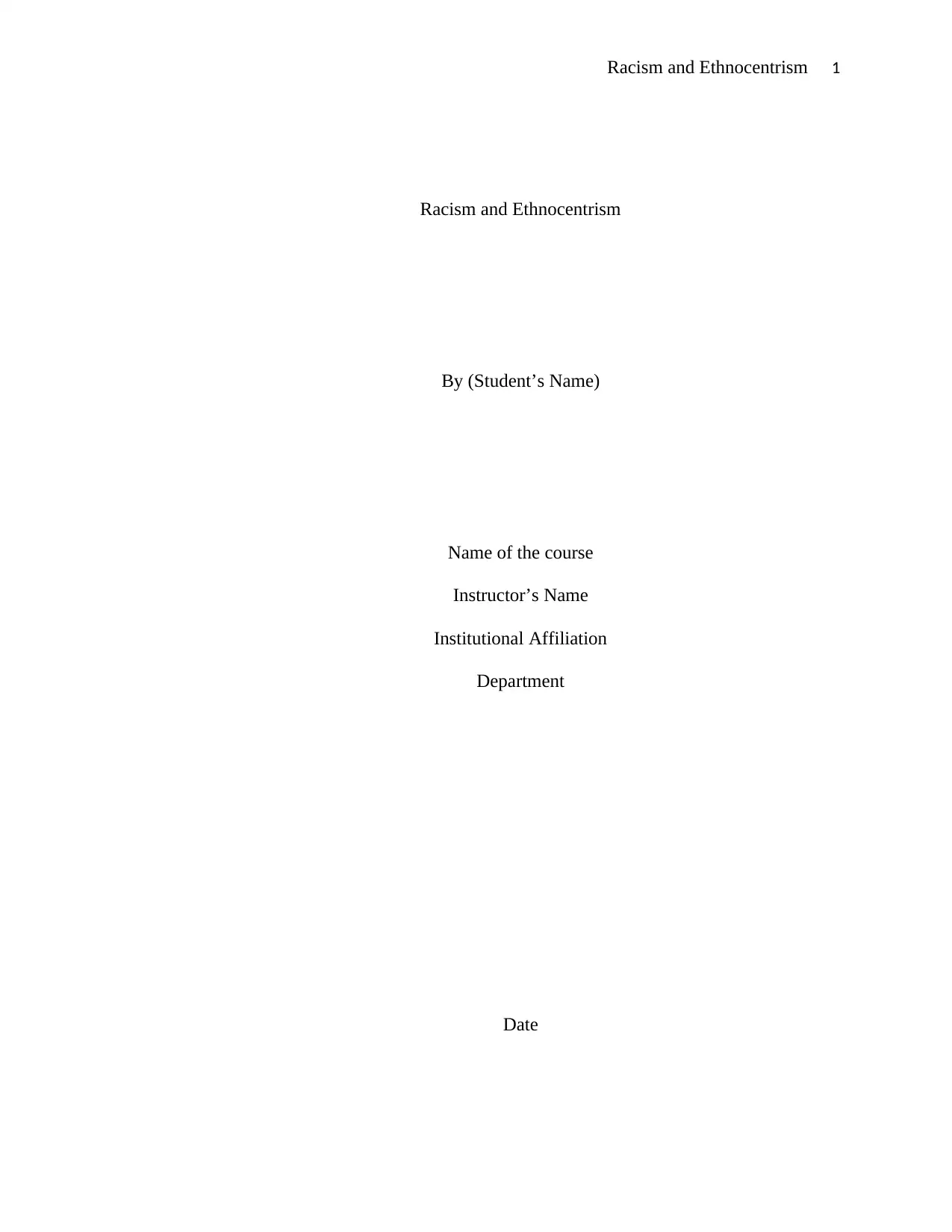
Racism and Ethnocentrism 1
Racism and Ethnocentrism
By (Student’s Name)
Name of the course
Instructor’s Name
Institutional Affiliation
Department
Date
Racism and Ethnocentrism
By (Student’s Name)
Name of the course
Instructor’s Name
Institutional Affiliation
Department
Date
Paraphrase This Document
Need a fresh take? Get an instant paraphrase of this document with our AI Paraphraser
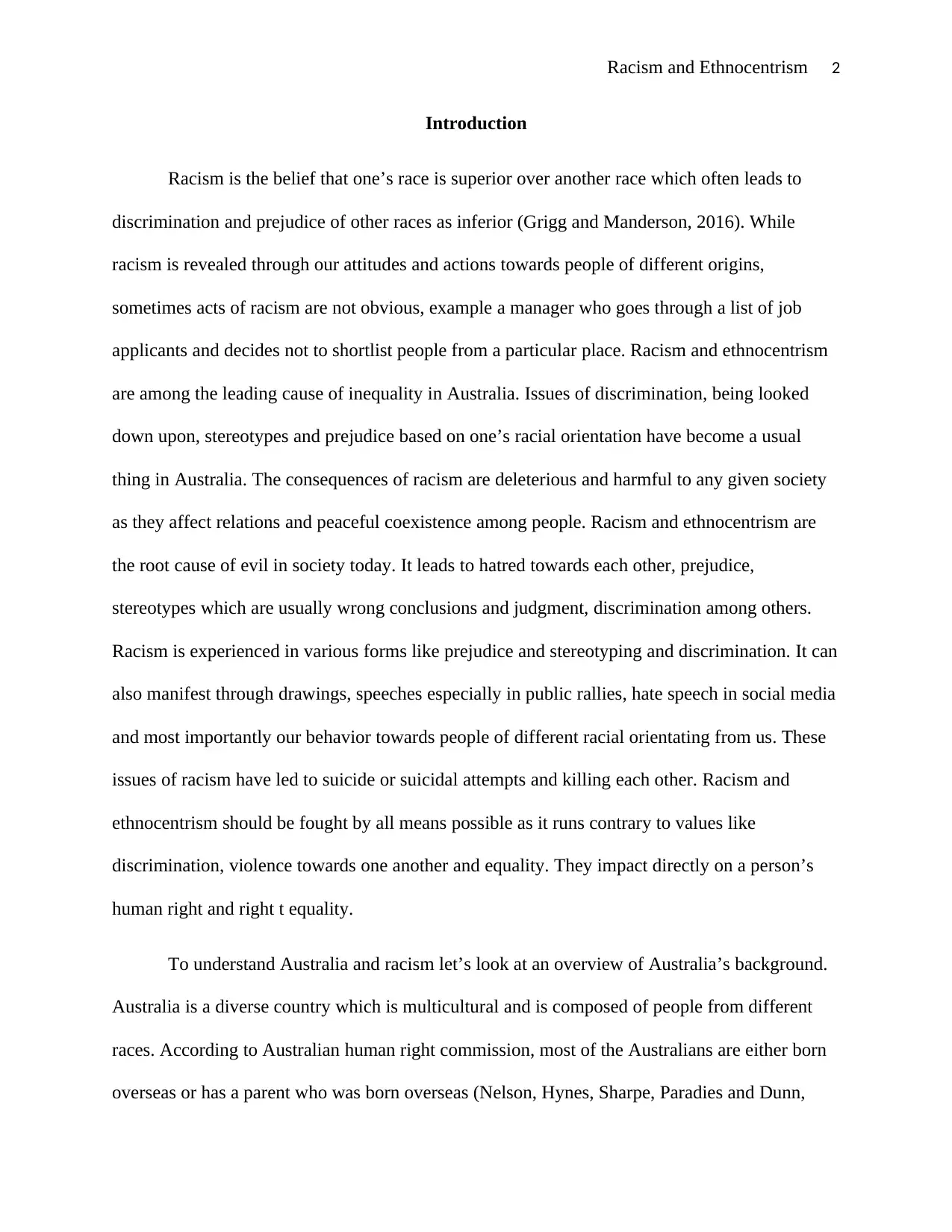
Racism and Ethnocentrism 2
Introduction
Racism is the belief that one’s race is superior over another race which often leads to
discrimination and prejudice of other races as inferior (Grigg and Manderson, 2016). While
racism is revealed through our attitudes and actions towards people of different origins,
sometimes acts of racism are not obvious, example a manager who goes through a list of job
applicants and decides not to shortlist people from a particular place. Racism and ethnocentrism
are among the leading cause of inequality in Australia. Issues of discrimination, being looked
down upon, stereotypes and prejudice based on one’s racial orientation have become a usual
thing in Australia. The consequences of racism are deleterious and harmful to any given society
as they affect relations and peaceful coexistence among people. Racism and ethnocentrism are
the root cause of evil in society today. It leads to hatred towards each other, prejudice,
stereotypes which are usually wrong conclusions and judgment, discrimination among others.
Racism is experienced in various forms like prejudice and stereotyping and discrimination. It can
also manifest through drawings, speeches especially in public rallies, hate speech in social media
and most importantly our behavior towards people of different racial orientating from us. These
issues of racism have led to suicide or suicidal attempts and killing each other. Racism and
ethnocentrism should be fought by all means possible as it runs contrary to values like
discrimination, violence towards one another and equality. They impact directly on a person’s
human right and right t equality.
To understand Australia and racism let’s look at an overview of Australia’s background.
Australia is a diverse country which is multicultural and is composed of people from different
races. According to Australian human right commission, most of the Australians are either born
overseas or has a parent who was born overseas (Nelson, Hynes, Sharpe, Paradies and Dunn,
Introduction
Racism is the belief that one’s race is superior over another race which often leads to
discrimination and prejudice of other races as inferior (Grigg and Manderson, 2016). While
racism is revealed through our attitudes and actions towards people of different origins,
sometimes acts of racism are not obvious, example a manager who goes through a list of job
applicants and decides not to shortlist people from a particular place. Racism and ethnocentrism
are among the leading cause of inequality in Australia. Issues of discrimination, being looked
down upon, stereotypes and prejudice based on one’s racial orientation have become a usual
thing in Australia. The consequences of racism are deleterious and harmful to any given society
as they affect relations and peaceful coexistence among people. Racism and ethnocentrism are
the root cause of evil in society today. It leads to hatred towards each other, prejudice,
stereotypes which are usually wrong conclusions and judgment, discrimination among others.
Racism is experienced in various forms like prejudice and stereotyping and discrimination. It can
also manifest through drawings, speeches especially in public rallies, hate speech in social media
and most importantly our behavior towards people of different racial orientating from us. These
issues of racism have led to suicide or suicidal attempts and killing each other. Racism and
ethnocentrism should be fought by all means possible as it runs contrary to values like
discrimination, violence towards one another and equality. They impact directly on a person’s
human right and right t equality.
To understand Australia and racism let’s look at an overview of Australia’s background.
Australia is a diverse country which is multicultural and is composed of people from different
races. According to Australian human right commission, most of the Australians are either born
overseas or has a parent who was born overseas (Nelson, Hynes, Sharpe, Paradies and Dunn,
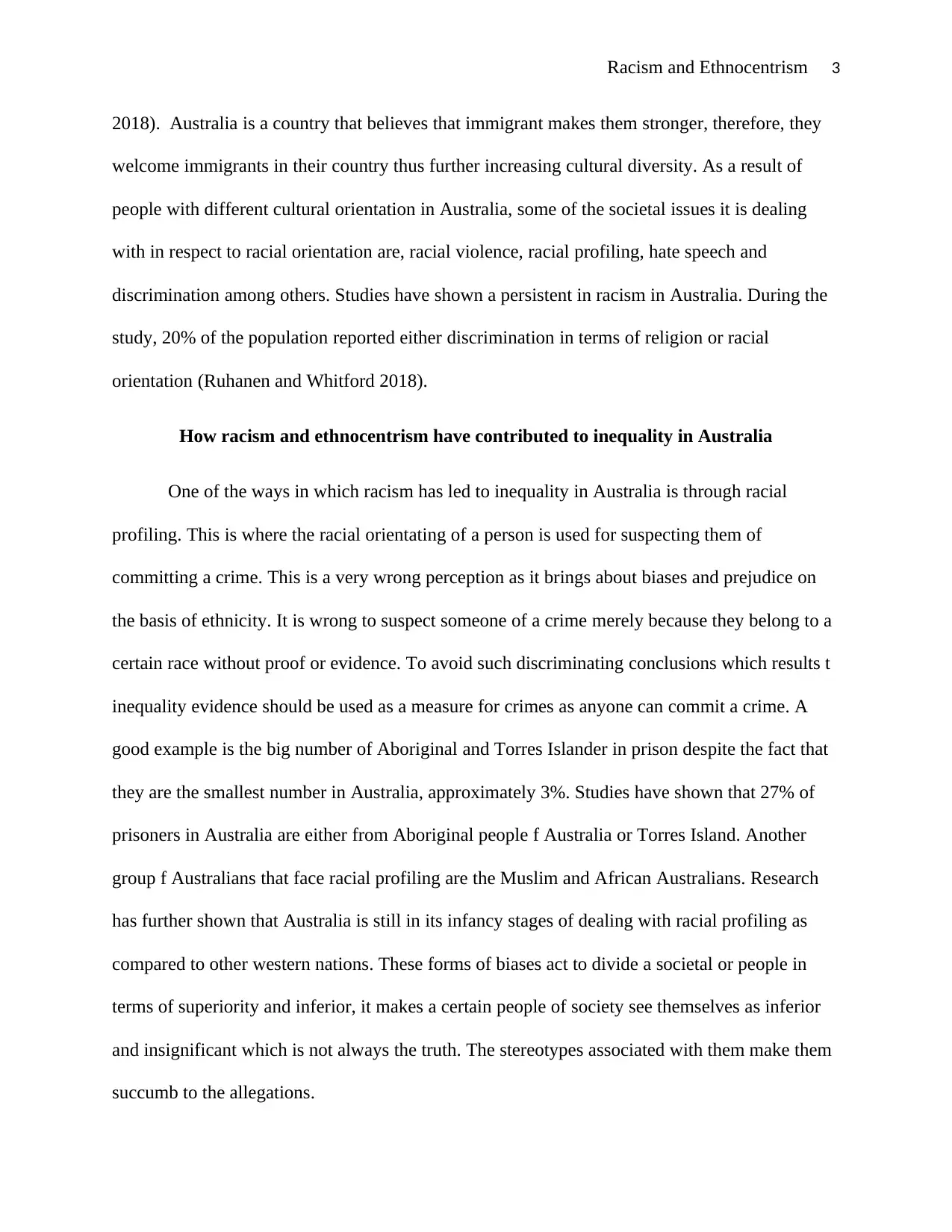
Racism and Ethnocentrism 3
2018). Australia is a country that believes that immigrant makes them stronger, therefore, they
welcome immigrants in their country thus further increasing cultural diversity. As a result of
people with different cultural orientation in Australia, some of the societal issues it is dealing
with in respect to racial orientation are, racial violence, racial profiling, hate speech and
discrimination among others. Studies have shown a persistent in racism in Australia. During the
study, 20% of the population reported either discrimination in terms of religion or racial
orientation (Ruhanen and Whitford 2018).
How racism and ethnocentrism have contributed to inequality in Australia
One of the ways in which racism has led to inequality in Australia is through racial
profiling. This is where the racial orientating of a person is used for suspecting them of
committing a crime. This is a very wrong perception as it brings about biases and prejudice on
the basis of ethnicity. It is wrong to suspect someone of a crime merely because they belong to a
certain race without proof or evidence. To avoid such discriminating conclusions which results t
inequality evidence should be used as a measure for crimes as anyone can commit a crime. A
good example is the big number of Aboriginal and Torres Islander in prison despite the fact that
they are the smallest number in Australia, approximately 3%. Studies have shown that 27% of
prisoners in Australia are either from Aboriginal people f Australia or Torres Island. Another
group f Australians that face racial profiling are the Muslim and African Australians. Research
has further shown that Australia is still in its infancy stages of dealing with racial profiling as
compared to other western nations. These forms of biases act to divide a societal or people in
terms of superiority and inferior, it makes a certain people of society see themselves as inferior
and insignificant which is not always the truth. The stereotypes associated with them make them
succumb to the allegations.
2018). Australia is a country that believes that immigrant makes them stronger, therefore, they
welcome immigrants in their country thus further increasing cultural diversity. As a result of
people with different cultural orientation in Australia, some of the societal issues it is dealing
with in respect to racial orientation are, racial violence, racial profiling, hate speech and
discrimination among others. Studies have shown a persistent in racism in Australia. During the
study, 20% of the population reported either discrimination in terms of religion or racial
orientation (Ruhanen and Whitford 2018).
How racism and ethnocentrism have contributed to inequality in Australia
One of the ways in which racism has led to inequality in Australia is through racial
profiling. This is where the racial orientating of a person is used for suspecting them of
committing a crime. This is a very wrong perception as it brings about biases and prejudice on
the basis of ethnicity. It is wrong to suspect someone of a crime merely because they belong to a
certain race without proof or evidence. To avoid such discriminating conclusions which results t
inequality evidence should be used as a measure for crimes as anyone can commit a crime. A
good example is the big number of Aboriginal and Torres Islander in prison despite the fact that
they are the smallest number in Australia, approximately 3%. Studies have shown that 27% of
prisoners in Australia are either from Aboriginal people f Australia or Torres Island. Another
group f Australians that face racial profiling are the Muslim and African Australians. Research
has further shown that Australia is still in its infancy stages of dealing with racial profiling as
compared to other western nations. These forms of biases act to divide a societal or people in
terms of superiority and inferior, it makes a certain people of society see themselves as inferior
and insignificant which is not always the truth. The stereotypes associated with them make them
succumb to the allegations.
⊘ This is a preview!⊘
Do you want full access?
Subscribe today to unlock all pages.

Trusted by 1+ million students worldwide
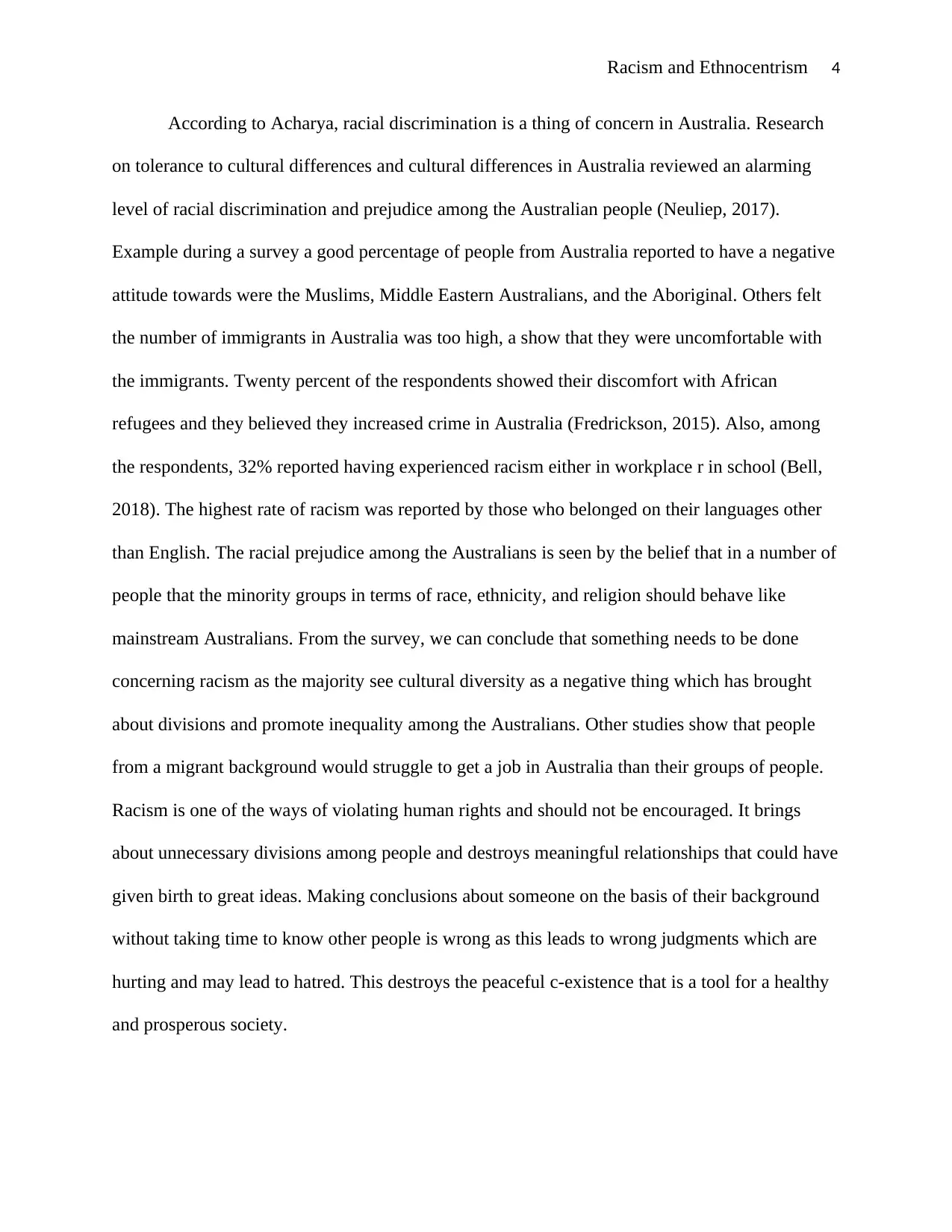
Racism and Ethnocentrism 4
According to Acharya, racial discrimination is a thing of concern in Australia. Research
on tolerance to cultural differences and cultural differences in Australia reviewed an alarming
level of racial discrimination and prejudice among the Australian people (Neuliep, 2017).
Example during a survey a good percentage of people from Australia reported to have a negative
attitude towards were the Muslims, Middle Eastern Australians, and the Aboriginal. Others felt
the number of immigrants in Australia was too high, a show that they were uncomfortable with
the immigrants. Twenty percent of the respondents showed their discomfort with African
refugees and they believed they increased crime in Australia (Fredrickson, 2015). Also, among
the respondents, 32% reported having experienced racism either in workplace r in school (Bell,
2018). The highest rate of racism was reported by those who belonged on their languages other
than English. The racial prejudice among the Australians is seen by the belief that in a number of
people that the minority groups in terms of race, ethnicity, and religion should behave like
mainstream Australians. From the survey, we can conclude that something needs to be done
concerning racism as the majority see cultural diversity as a negative thing which has brought
about divisions and promote inequality among the Australians. Other studies show that people
from a migrant background would struggle to get a job in Australia than their groups of people.
Racism is one of the ways of violating human rights and should not be encouraged. It brings
about unnecessary divisions among people and destroys meaningful relationships that could have
given birth to great ideas. Making conclusions about someone on the basis of their background
without taking time to know other people is wrong as this leads to wrong judgments which are
hurting and may lead to hatred. This destroys the peaceful c-existence that is a tool for a healthy
and prosperous society.
According to Acharya, racial discrimination is a thing of concern in Australia. Research
on tolerance to cultural differences and cultural differences in Australia reviewed an alarming
level of racial discrimination and prejudice among the Australian people (Neuliep, 2017).
Example during a survey a good percentage of people from Australia reported to have a negative
attitude towards were the Muslims, Middle Eastern Australians, and the Aboriginal. Others felt
the number of immigrants in Australia was too high, a show that they were uncomfortable with
the immigrants. Twenty percent of the respondents showed their discomfort with African
refugees and they believed they increased crime in Australia (Fredrickson, 2015). Also, among
the respondents, 32% reported having experienced racism either in workplace r in school (Bell,
2018). The highest rate of racism was reported by those who belonged on their languages other
than English. The racial prejudice among the Australians is seen by the belief that in a number of
people that the minority groups in terms of race, ethnicity, and religion should behave like
mainstream Australians. From the survey, we can conclude that something needs to be done
concerning racism as the majority see cultural diversity as a negative thing which has brought
about divisions and promote inequality among the Australians. Other studies show that people
from a migrant background would struggle to get a job in Australia than their groups of people.
Racism is one of the ways of violating human rights and should not be encouraged. It brings
about unnecessary divisions among people and destroys meaningful relationships that could have
given birth to great ideas. Making conclusions about someone on the basis of their background
without taking time to know other people is wrong as this leads to wrong judgments which are
hurting and may lead to hatred. This destroys the peaceful c-existence that is a tool for a healthy
and prosperous society.
Paraphrase This Document
Need a fresh take? Get an instant paraphrase of this document with our AI Paraphraser
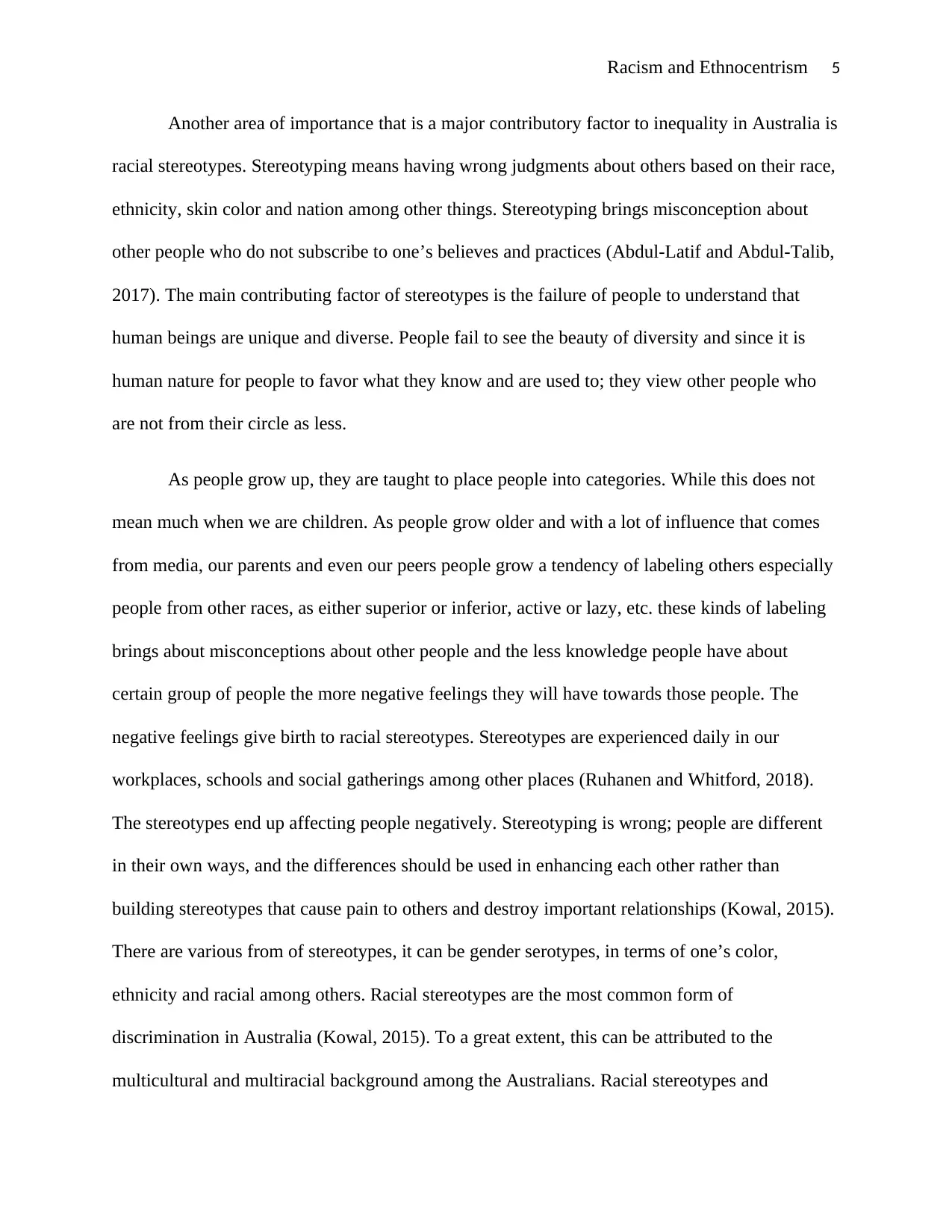
Racism and Ethnocentrism 5
Another area of importance that is a major contributory factor to inequality in Australia is
racial stereotypes. Stereotyping means having wrong judgments about others based on their race,
ethnicity, skin color and nation among other things. Stereotyping brings misconception about
other people who do not subscribe to one’s believes and practices (Abdul-Latif and Abdul-Talib,
2017). The main contributing factor of stereotypes is the failure of people to understand that
human beings are unique and diverse. People fail to see the beauty of diversity and since it is
human nature for people to favor what they know and are used to; they view other people who
are not from their circle as less.
As people grow up, they are taught to place people into categories. While this does not
mean much when we are children. As people grow older and with a lot of influence that comes
from media, our parents and even our peers people grow a tendency of labeling others especially
people from other races, as either superior or inferior, active or lazy, etc. these kinds of labeling
brings about misconceptions about other people and the less knowledge people have about
certain group of people the more negative feelings they will have towards those people. The
negative feelings give birth to racial stereotypes. Stereotypes are experienced daily in our
workplaces, schools and social gatherings among other places (Ruhanen and Whitford, 2018).
The stereotypes end up affecting people negatively. Stereotyping is wrong; people are different
in their own ways, and the differences should be used in enhancing each other rather than
building stereotypes that cause pain to others and destroy important relationships (Kowal, 2015).
There are various from of stereotypes, it can be gender serotypes, in terms of one’s color,
ethnicity and racial among others. Racial stereotypes are the most common form of
discrimination in Australia (Kowal, 2015). To a great extent, this can be attributed to the
multicultural and multiracial background among the Australians. Racial stereotypes and
Another area of importance that is a major contributory factor to inequality in Australia is
racial stereotypes. Stereotyping means having wrong judgments about others based on their race,
ethnicity, skin color and nation among other things. Stereotyping brings misconception about
other people who do not subscribe to one’s believes and practices (Abdul-Latif and Abdul-Talib,
2017). The main contributing factor of stereotypes is the failure of people to understand that
human beings are unique and diverse. People fail to see the beauty of diversity and since it is
human nature for people to favor what they know and are used to; they view other people who
are not from their circle as less.
As people grow up, they are taught to place people into categories. While this does not
mean much when we are children. As people grow older and with a lot of influence that comes
from media, our parents and even our peers people grow a tendency of labeling others especially
people from other races, as either superior or inferior, active or lazy, etc. these kinds of labeling
brings about misconceptions about other people and the less knowledge people have about
certain group of people the more negative feelings they will have towards those people. The
negative feelings give birth to racial stereotypes. Stereotypes are experienced daily in our
workplaces, schools and social gatherings among other places (Ruhanen and Whitford, 2018).
The stereotypes end up affecting people negatively. Stereotyping is wrong; people are different
in their own ways, and the differences should be used in enhancing each other rather than
building stereotypes that cause pain to others and destroy important relationships (Kowal, 2015).
There are various from of stereotypes, it can be gender serotypes, in terms of one’s color,
ethnicity and racial among others. Racial stereotypes are the most common form of
discrimination in Australia (Kowal, 2015). To a great extent, this can be attributed to the
multicultural and multiracial background among the Australians. Racial stereotypes and
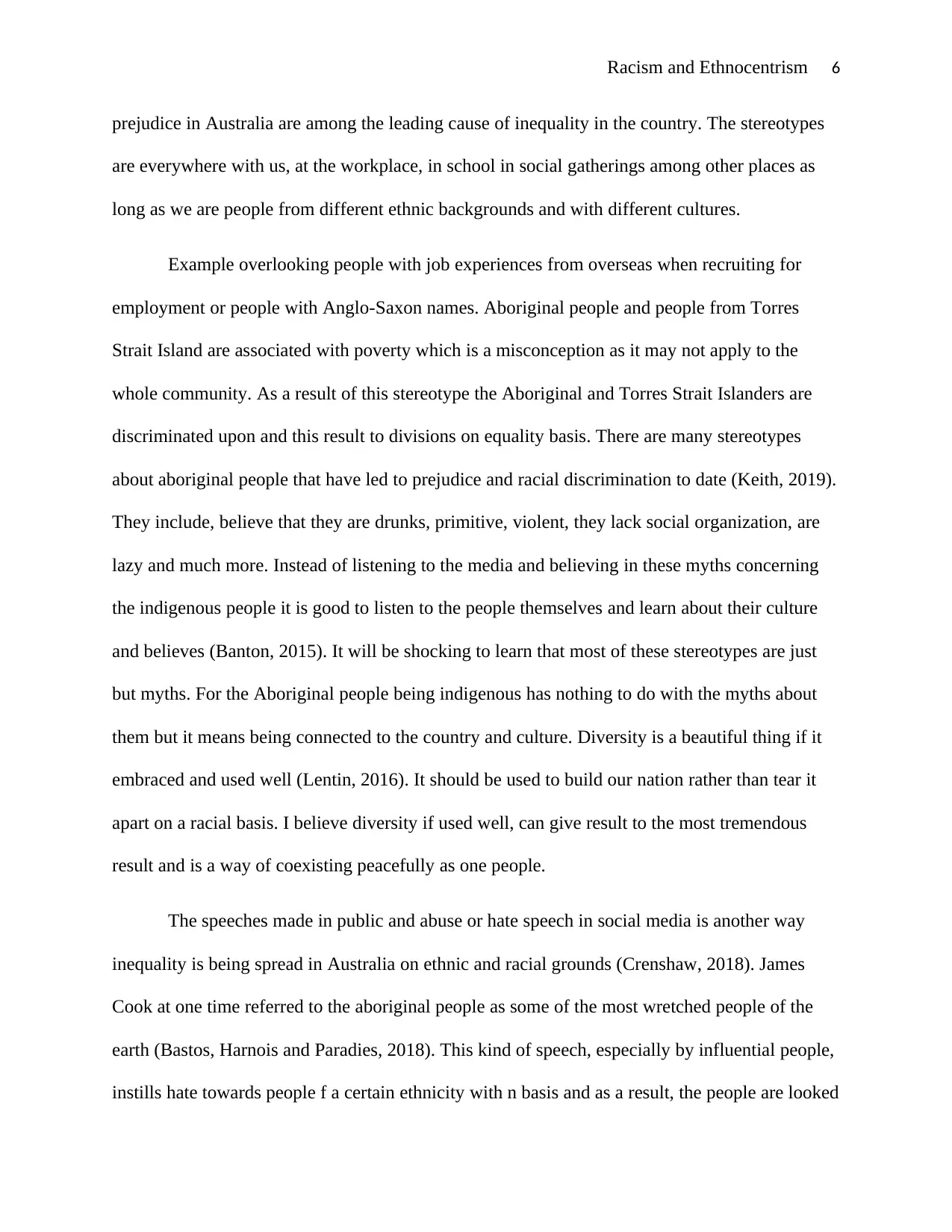
Racism and Ethnocentrism 6
prejudice in Australia are among the leading cause of inequality in the country. The stereotypes
are everywhere with us, at the workplace, in school in social gatherings among other places as
long as we are people from different ethnic backgrounds and with different cultures.
Example overlooking people with job experiences from overseas when recruiting for
employment or people with Anglo-Saxon names. Aboriginal people and people from Torres
Strait Island are associated with poverty which is a misconception as it may not apply to the
whole community. As a result of this stereotype the Aboriginal and Torres Strait Islanders are
discriminated upon and this result to divisions on equality basis. There are many stereotypes
about aboriginal people that have led to prejudice and racial discrimination to date (Keith, 2019).
They include, believe that they are drunks, primitive, violent, they lack social organization, are
lazy and much more. Instead of listening to the media and believing in these myths concerning
the indigenous people it is good to listen to the people themselves and learn about their culture
and believes (Banton, 2015). It will be shocking to learn that most of these stereotypes are just
but myths. For the Aboriginal people being indigenous has nothing to do with the myths about
them but it means being connected to the country and culture. Diversity is a beautiful thing if it
embraced and used well (Lentin, 2016). It should be used to build our nation rather than tear it
apart on a racial basis. I believe diversity if used well, can give result to the most tremendous
result and is a way of coexisting peacefully as one people.
The speeches made in public and abuse or hate speech in social media is another way
inequality is being spread in Australia on ethnic and racial grounds (Crenshaw, 2018). James
Cook at one time referred to the aboriginal people as some of the most wretched people of the
earth (Bastos, Harnois and Paradies, 2018). This kind of speech, especially by influential people,
instills hate towards people f a certain ethnicity with n basis and as a result, the people are looked
prejudice in Australia are among the leading cause of inequality in the country. The stereotypes
are everywhere with us, at the workplace, in school in social gatherings among other places as
long as we are people from different ethnic backgrounds and with different cultures.
Example overlooking people with job experiences from overseas when recruiting for
employment or people with Anglo-Saxon names. Aboriginal people and people from Torres
Strait Island are associated with poverty which is a misconception as it may not apply to the
whole community. As a result of this stereotype the Aboriginal and Torres Strait Islanders are
discriminated upon and this result to divisions on equality basis. There are many stereotypes
about aboriginal people that have led to prejudice and racial discrimination to date (Keith, 2019).
They include, believe that they are drunks, primitive, violent, they lack social organization, are
lazy and much more. Instead of listening to the media and believing in these myths concerning
the indigenous people it is good to listen to the people themselves and learn about their culture
and believes (Banton, 2015). It will be shocking to learn that most of these stereotypes are just
but myths. For the Aboriginal people being indigenous has nothing to do with the myths about
them but it means being connected to the country and culture. Diversity is a beautiful thing if it
embraced and used well (Lentin, 2016). It should be used to build our nation rather than tear it
apart on a racial basis. I believe diversity if used well, can give result to the most tremendous
result and is a way of coexisting peacefully as one people.
The speeches made in public and abuse or hate speech in social media is another way
inequality is being spread in Australia on ethnic and racial grounds (Crenshaw, 2018). James
Cook at one time referred to the aboriginal people as some of the most wretched people of the
earth (Bastos, Harnois and Paradies, 2018). This kind of speech, especially by influential people,
instills hate towards people f a certain ethnicity with n basis and as a result, the people are looked
⊘ This is a preview!⊘
Do you want full access?
Subscribe today to unlock all pages.

Trusted by 1+ million students worldwide
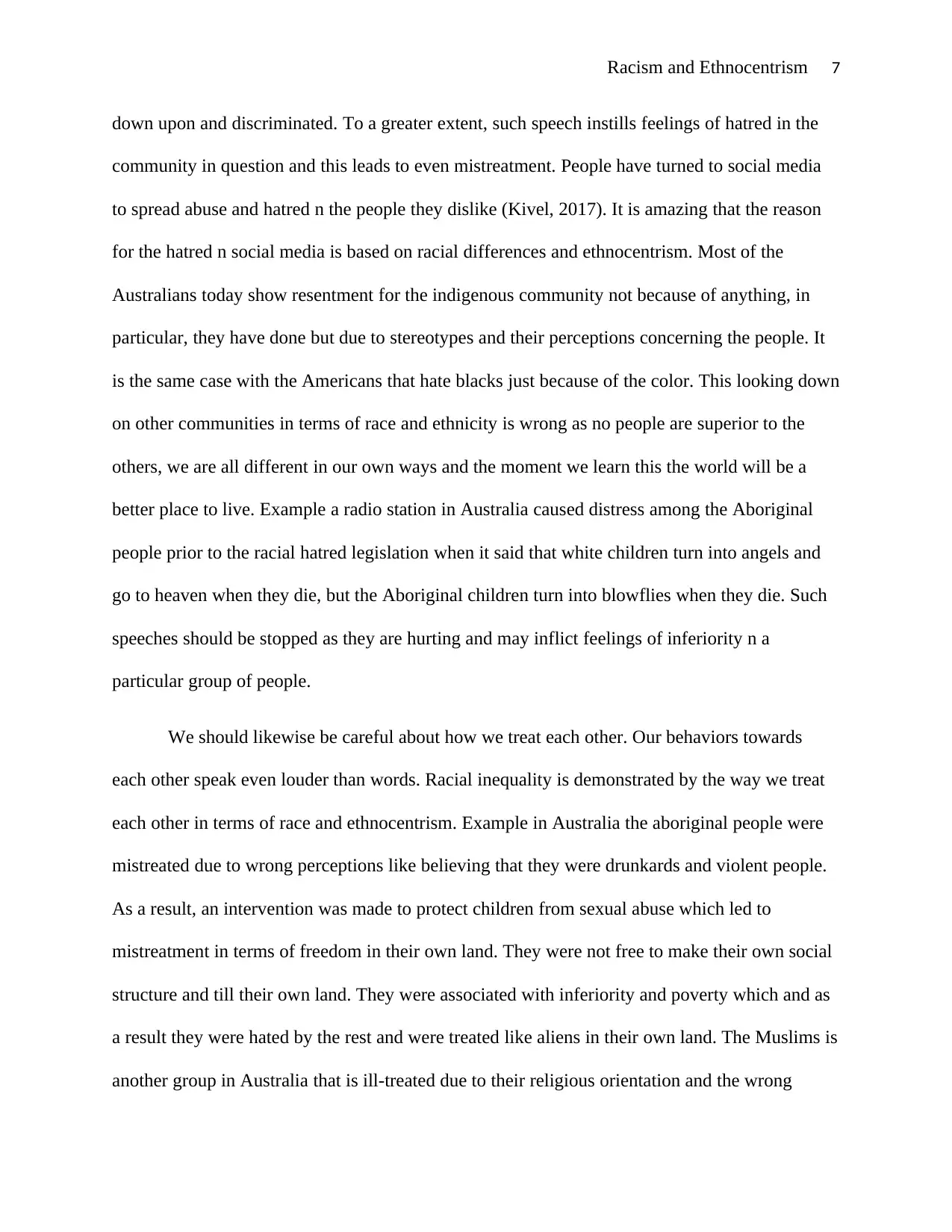
Racism and Ethnocentrism 7
down upon and discriminated. To a greater extent, such speech instills feelings of hatred in the
community in question and this leads to even mistreatment. People have turned to social media
to spread abuse and hatred n the people they dislike (Kivel, 2017). It is amazing that the reason
for the hatred n social media is based on racial differences and ethnocentrism. Most of the
Australians today show resentment for the indigenous community not because of anything, in
particular, they have done but due to stereotypes and their perceptions concerning the people. It
is the same case with the Americans that hate blacks just because of the color. This looking down
on other communities in terms of race and ethnicity is wrong as no people are superior to the
others, we are all different in our own ways and the moment we learn this the world will be a
better place to live. Example a radio station in Australia caused distress among the Aboriginal
people prior to the racial hatred legislation when it said that white children turn into angels and
go to heaven when they die, but the Aboriginal children turn into blowflies when they die. Such
speeches should be stopped as they are hurting and may inflict feelings of inferiority n a
particular group of people.
We should likewise be careful about how we treat each other. Our behaviors towards
each other speak even louder than words. Racial inequality is demonstrated by the way we treat
each other in terms of race and ethnocentrism. Example in Australia the aboriginal people were
mistreated due to wrong perceptions like believing that they were drunkards and violent people.
As a result, an intervention was made to protect children from sexual abuse which led to
mistreatment in terms of freedom in their own land. They were not free to make their own social
structure and till their own land. They were associated with inferiority and poverty which and as
a result they were hated by the rest and were treated like aliens in their own land. The Muslims is
another group in Australia that is ill-treated due to their religious orientation and the wrong
down upon and discriminated. To a greater extent, such speech instills feelings of hatred in the
community in question and this leads to even mistreatment. People have turned to social media
to spread abuse and hatred n the people they dislike (Kivel, 2017). It is amazing that the reason
for the hatred n social media is based on racial differences and ethnocentrism. Most of the
Australians today show resentment for the indigenous community not because of anything, in
particular, they have done but due to stereotypes and their perceptions concerning the people. It
is the same case with the Americans that hate blacks just because of the color. This looking down
on other communities in terms of race and ethnicity is wrong as no people are superior to the
others, we are all different in our own ways and the moment we learn this the world will be a
better place to live. Example a radio station in Australia caused distress among the Aboriginal
people prior to the racial hatred legislation when it said that white children turn into angels and
go to heaven when they die, but the Aboriginal children turn into blowflies when they die. Such
speeches should be stopped as they are hurting and may inflict feelings of inferiority n a
particular group of people.
We should likewise be careful about how we treat each other. Our behaviors towards
each other speak even louder than words. Racial inequality is demonstrated by the way we treat
each other in terms of race and ethnocentrism. Example in Australia the aboriginal people were
mistreated due to wrong perceptions like believing that they were drunkards and violent people.
As a result, an intervention was made to protect children from sexual abuse which led to
mistreatment in terms of freedom in their own land. They were not free to make their own social
structure and till their own land. They were associated with inferiority and poverty which and as
a result they were hated by the rest and were treated like aliens in their own land. The Muslims is
another group in Australia that is ill-treated due to their religious orientation and the wrong
Paraphrase This Document
Need a fresh take? Get an instant paraphrase of this document with our AI Paraphraser
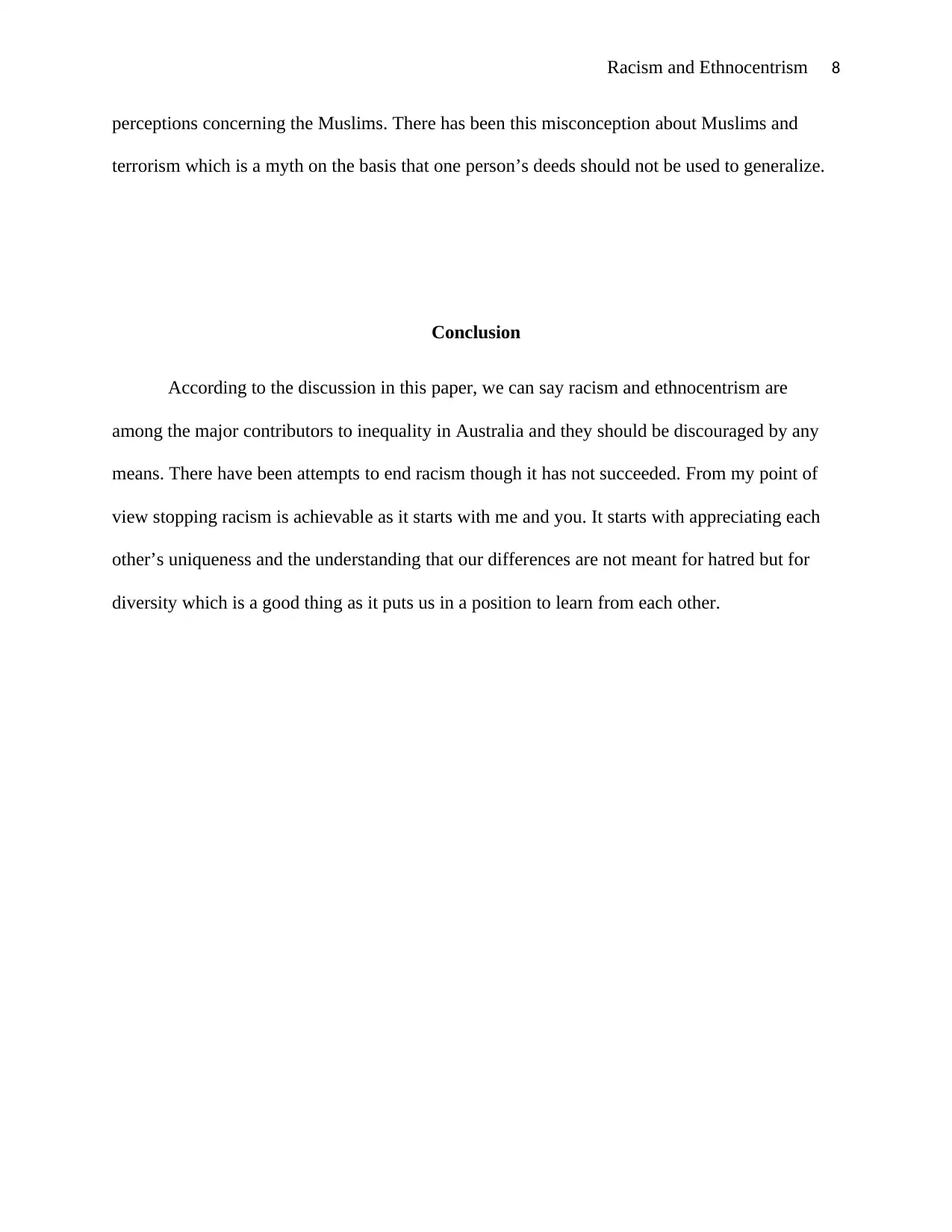
Racism and Ethnocentrism 8
perceptions concerning the Muslims. There has been this misconception about Muslims and
terrorism which is a myth on the basis that one person’s deeds should not be used to generalize.
Conclusion
According to the discussion in this paper, we can say racism and ethnocentrism are
among the major contributors to inequality in Australia and they should be discouraged by any
means. There have been attempts to end racism though it has not succeeded. From my point of
view stopping racism is achievable as it starts with me and you. It starts with appreciating each
other’s uniqueness and the understanding that our differences are not meant for hatred but for
diversity which is a good thing as it puts us in a position to learn from each other.
perceptions concerning the Muslims. There has been this misconception about Muslims and
terrorism which is a myth on the basis that one person’s deeds should not be used to generalize.
Conclusion
According to the discussion in this paper, we can say racism and ethnocentrism are
among the major contributors to inequality in Australia and they should be discouraged by any
means. There have been attempts to end racism though it has not succeeded. From my point of
view stopping racism is achievable as it starts with me and you. It starts with appreciating each
other’s uniqueness and the understanding that our differences are not meant for hatred but for
diversity which is a good thing as it puts us in a position to learn from each other.

Racism and Ethnocentrism 9
References
Abdul-Latif, S.A. and Abdul-Talib, A.N., 2017. Consumer racism: a scale modification. Asia
Pacific Journal of Marketing and Logistics, 29(3), pp.616-633.
Banton, M., 2015. Racism. The Wiley Blackwell Encyclopedia of Race, Ethnicity, and
Nationalism, pp.1-8.
Bastos, J.L., Harnois, C.E. and Paradies, Y.C., 2018. Health care barriers, racism, and
intersectionality in Australia. Social Science & Medicine, 199, pp.209-218.
Bell, D., 2018. Faces at the bottom of the well: The permanence of racism. 2nd ed. Hachette UK.
Crenshaw, K.W., 2018. Beyond racism and misogyny: Black feminism. 3rd ed. New York:
Routledge.
Fredrickson, G.M., 2015. Racism: A short history. 3rd ed. New York: Princeton University Press.
Grigg, K. and Manderson, L., 2016. The Australian racism, acceptance, and cultural-
ethnocentrism scale (RACES): item response theory findings. International journal for equity in
health, 15(1), p.49.
Jonason, P.K., 2015. How “dark” personality traits and perceptions come together to predict
racism in Australia. Personality and Individual Differences, 72, pp.47-51.
Keith, K.D., 2019. Ethnocentrism: Seeing the world from where we stand. Cross‐cultural
psychology: Contemporary themes and perspectives, pp.23-38.
Kivel, P., 2017. Uprooting Racism-: How White People Can Work for Racial Justice. 3rd ed.
New York: New Society Publishers.
References
Abdul-Latif, S.A. and Abdul-Talib, A.N., 2017. Consumer racism: a scale modification. Asia
Pacific Journal of Marketing and Logistics, 29(3), pp.616-633.
Banton, M., 2015. Racism. The Wiley Blackwell Encyclopedia of Race, Ethnicity, and
Nationalism, pp.1-8.
Bastos, J.L., Harnois, C.E. and Paradies, Y.C., 2018. Health care barriers, racism, and
intersectionality in Australia. Social Science & Medicine, 199, pp.209-218.
Bell, D., 2018. Faces at the bottom of the well: The permanence of racism. 2nd ed. Hachette UK.
Crenshaw, K.W., 2018. Beyond racism and misogyny: Black feminism. 3rd ed. New York:
Routledge.
Fredrickson, G.M., 2015. Racism: A short history. 3rd ed. New York: Princeton University Press.
Grigg, K. and Manderson, L., 2016. The Australian racism, acceptance, and cultural-
ethnocentrism scale (RACES): item response theory findings. International journal for equity in
health, 15(1), p.49.
Jonason, P.K., 2015. How “dark” personality traits and perceptions come together to predict
racism in Australia. Personality and Individual Differences, 72, pp.47-51.
Keith, K.D., 2019. Ethnocentrism: Seeing the world from where we stand. Cross‐cultural
psychology: Contemporary themes and perspectives, pp.23-38.
Kivel, P., 2017. Uprooting Racism-: How White People Can Work for Racial Justice. 3rd ed.
New York: New Society Publishers.
⊘ This is a preview!⊘
Do you want full access?
Subscribe today to unlock all pages.

Trusted by 1+ million students worldwide
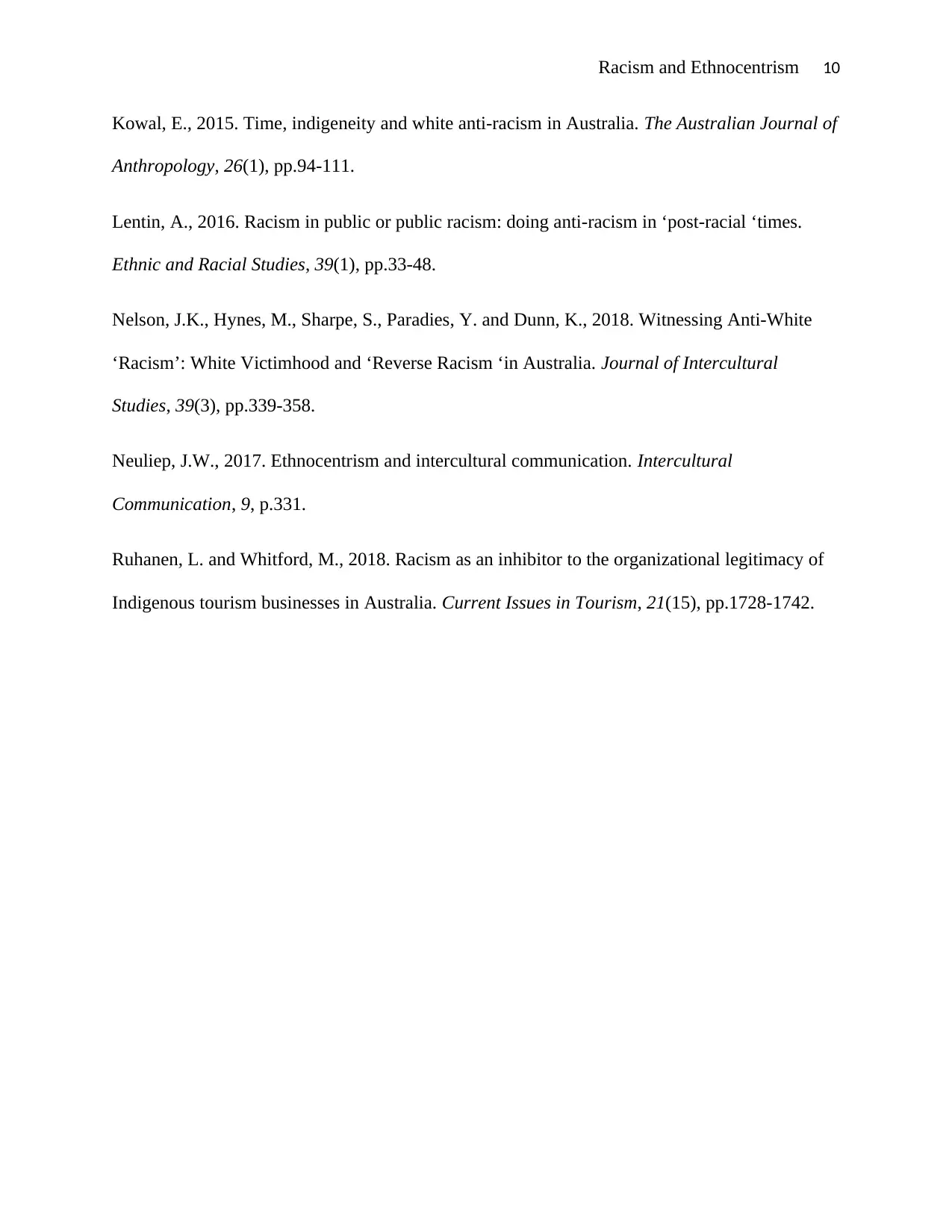
Racism and Ethnocentrism 10
Kowal, E., 2015. Time, indigeneity and white anti‐racism in Australia. The Australian Journal of
Anthropology, 26(1), pp.94-111.
Lentin, A., 2016. Racism in public or public racism: doing anti-racism in ‘post-racial ‘times.
Ethnic and Racial Studies, 39(1), pp.33-48.
Nelson, J.K., Hynes, M., Sharpe, S., Paradies, Y. and Dunn, K., 2018. Witnessing Anti-White
‘Racism’: White Victimhood and ‘Reverse Racism ‘in Australia. Journal of Intercultural
Studies, 39(3), pp.339-358.
Neuliep, J.W., 2017. Ethnocentrism and intercultural communication. Intercultural
Communication, 9, p.331.
Ruhanen, L. and Whitford, M., 2018. Racism as an inhibitor to the organizational legitimacy of
Indigenous tourism businesses in Australia. Current Issues in Tourism, 21(15), pp.1728-1742.
Kowal, E., 2015. Time, indigeneity and white anti‐racism in Australia. The Australian Journal of
Anthropology, 26(1), pp.94-111.
Lentin, A., 2016. Racism in public or public racism: doing anti-racism in ‘post-racial ‘times.
Ethnic and Racial Studies, 39(1), pp.33-48.
Nelson, J.K., Hynes, M., Sharpe, S., Paradies, Y. and Dunn, K., 2018. Witnessing Anti-White
‘Racism’: White Victimhood and ‘Reverse Racism ‘in Australia. Journal of Intercultural
Studies, 39(3), pp.339-358.
Neuliep, J.W., 2017. Ethnocentrism and intercultural communication. Intercultural
Communication, 9, p.331.
Ruhanen, L. and Whitford, M., 2018. Racism as an inhibitor to the organizational legitimacy of
Indigenous tourism businesses in Australia. Current Issues in Tourism, 21(15), pp.1728-1742.
1 out of 10
Related Documents
Your All-in-One AI-Powered Toolkit for Academic Success.
+13062052269
info@desklib.com
Available 24*7 on WhatsApp / Email
![[object Object]](/_next/static/media/star-bottom.7253800d.svg)
Unlock your academic potential
Copyright © 2020–2025 A2Z Services. All Rights Reserved. Developed and managed by ZUCOL.



